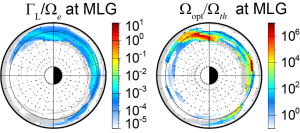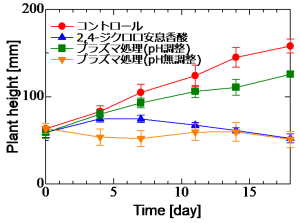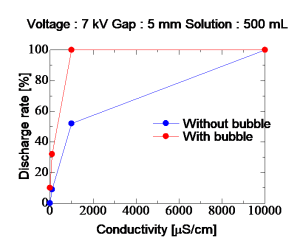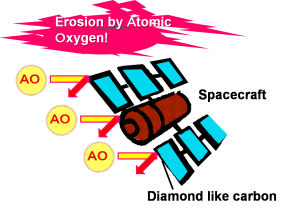2020 Activity Report for Mission 3: Sustainable Space Environments for Humankind
Updated: 2021/04/30
Research 1: Regions where chorus waves nonlinearly grow
Principal Investigator (PI): Yusuke Ebihara (RISH, Kyoto University)
Research collaborator(s): Takuya Ikeda (RISH, Kyoto University), Takashi Tanaka (Kyushu University).
We show the regions where whistler‐mode chorus waves are preferred to grow due to nonlinear mechanism in the inner magnetosphere. We used a global magnetohydrodynamics (MHD) simulation and an advection simulation. The major results are as follows. (1) The whistler waves can first grow due to the linear mechanism in the premidnight‐prenoon region outside the plasmapause, followed by rapid, nonlinear mechanism. (2) When the solar wind speed is high, the whistler waves grow more efficiently due to linear and nonlinear mechanisms over a wider area. This result is consistent with the observation that the outer belt electrons increase for the fast solar wind. (3) When the solar wind speed is low, the linear growth is mostly suppressed, but the nonlinear growth can still take place when external seed waves are present.
Publication
Ebihara, Y., T. Ikeda, Y. Omura, T. Tanaka, and M. -C. Fok, Nonlinear wave growth analysis of whistler-mode chorus generation regions based on coupled MHD and advection simulation of the inner magnetosphere, J. Geophys. Res. Space Phys., 125, 1, e2019JA026951, doi:10.1029/2019JA026951, 2020
Research 2: Study on dynamic variation of relativistic electron fluxes in the radiation belts
Principal Investigator (PI): Yoshiharu Omura (RISH, Kyoto University)
Research collaborator: Yikai Hsieh (RISH, Kyoto University)
Using results of test particle simulations of electrons interacting with whistler mode chorus emissions, we numerically obtain Green’s functions to model evolution of the electron distribution function after all of the possible interactions with the waves. Modifying the numerical Green’s function method with the simplified model of chorus waves uniform in longitude, we compute the formation process of the outer radiation belt electron fluxes induced by the interaction with the chorus waves localized in longitude occurring for a time scale of 1 hr. The formation of MeV electron fluxes is characterized by large acceleration rates and butterfly pitch angle distributions, which are found in satellite observation results (Hsieh et al., 2020). In observations, the Earthward boundary of the outer radiation belt is called the impenetrable barrier because it is nearly constant. Through our analysis of the wave and particle data from the Van Allen Probes based on the nonlinear wave growth theory (Omura, 2021), we found that the barrier is due to man-made signals from VLF transmitters. The efficient acceleration by chorus emissions does not take place, because the VLF signals precipitate energetic electrons into loss-cone which are the source for chorus emissions (Foster et al. 2020).

Formation of radiation belt due to electron acceleration by chorus emissions localized in longitudes
Publication
- Y.-K. Hsieh, Y. Kubota, Y. Omura (2020), Nonlinear evolution of radiation belt electron fluxes interacting with oblique whistler mode chorus emissions. Journal of Geophysical Research: Space Physics, 125, e2019JA027465. https://doi.org/10.1029/2019JA027465.
- Y.Omura (2021), Nonlinear wave growth theory of whistler‑mode chorus and hiss emissions in the magnetosphere, Earth, Planets and Space, 73:95, https://doi.org/10.1186/s40623-021-01380-w.
- J.C. Foster, P. J. Erickson, Y. Omura, and D. N. Baker (2020), The impenetrable barrier: Suppression of chorus wave growth by VLF transmitters, Journal of Geophysical Research: Space Physics, 125, e2020JA027913, https://doi.org/10.1029/2020JA027913.
Research 3: Development of miniaturized plasma wave instruments for monitoring space electromagnetic environments
Principal Investigator (PI): Hirotsugu Kojima (RISH, Kyoto University)
Research collaborators: Motoyuki Kikukawa (Graduate school of engineering, Kyoto university), Kazushi Asamura (JAXA)
Wave-particle interaction is a basic process of energy transportation in space plasmas. Since space plasmas are intrinsically colisionless, kinetic energies of plasma particles are exchanged through wave-particle interactions. One of key issues in understanding space electromagnetic environments through satellite observations is to directly measure wave-particle interactions. Wave-particle interaction analyzer or (WPIA) is a unique method for quantitatively evaluating wave-particle interactions in satellite observations. It has the capability to identify relative phase angles between particle velocity vectors and wave vectors, which are essential in pursuing to calculate energy flows. However, the WPIA requires a lot of resources in its mass, size, and power consumption. That does not fit capacities of small- or nanosatellites. To meet the resources of small- or nanosatellites, the present study attempts to miniaturize the WPIA circuit using the ASIC technology. In FY2020, the stabilizations of the small chip device designed for particle detecting circuits have been made. The figure shows the layout inside the designed chip. It contains a series of circuits that pick up current pulses with the pulse width less than a few nanoseconds from particle detectors and amplify the signal as the voltage output. The size of the circuit is 0.21mm x 0.57mm for one channel. The output of this circuit is fed to a plasma wave receiver to compare with waveform data. The result well shows the feasibility of so-called one-chip WPIA. The further detailed design of the chip will be made in the future.
Research 4:Basic and applied research on fine bubble water for space missions
Principal Investigator (PI): Yoshikatsu Ueda (RISH, Kyoto University)
Research collaborator(s): Katsuyuki Takahashi (Iwate University)
We have been studying basic and applied research on fine bubble water as a new material expected to be used in space missions in the future. We started to study the relationship between bubbles and plasma in water, and evaluated the ecological effects of the treated solution on plants by trying to decompose plant growth inhibitors. 2,4-dichlorobenzoic acid, a growth inhibitor of cucumber, was used as a sample. Plasma treatment decomposed and removed the 2,4-dichlorobenzoic acid, and when cucumbers were grown in the treated solution, they grew healthily. In order to solve the problem of low energy efficiency, which is an issue of the underwater plasma system, we tried to improve the energy balance related to plasma generation by introducing fine bubbles into the water. It was found that the introduction of fine bubbles reduced the breakdown voltage by half and promoted more ionization. This was found to be particularly effective when the pulse width was short. It was also found that when the conductivity of the solution was varied and a sufficient voltage was applied, the discharge probability decreased with decreasing conductivity, but the decrease was suppressed in the presence of bubbles.
Research 5: Prediction of AO Resistance of Urushi Carbonized-DLC Films by EELS
Principal Investigator (PI): Toshimitsu Hata (RISH, Kyoto University)
Research collaborator(s): Hirotugu Kojima, Yuki Tobimatsu (RISH, Kyoto University)
The surface materials of spacecrafts are rapidly oxidized by atomic oxygen (AO) in low-Earth orbit at altitudes of 200 to 700 km. To produce materials resistant to AO, the DLC films and their original woody carbon targets were irradiated with AO, and the resulting compounds and amount of material loss were investigated. Electron energy loss spectroscopy (EELS) was used to determine the elemental ratios of the DLC films, and the ratio of silicon increased with AO irradiation. This is due to the transformation of carbon materials into gases such as CO and CO2 and individual residue SiO2 by AO irradiation. Multiple regression analysis of the original wood carbon target predicted that compounds containing SiO2 and C=O would be resistant to AO irradiation, indicating that Si-containing carbonized wood may provide AO resistance.







